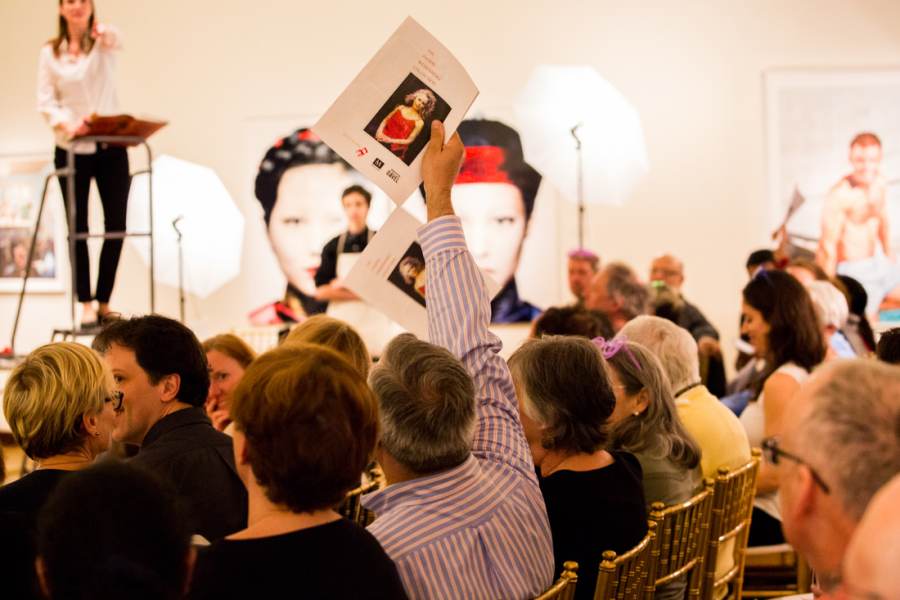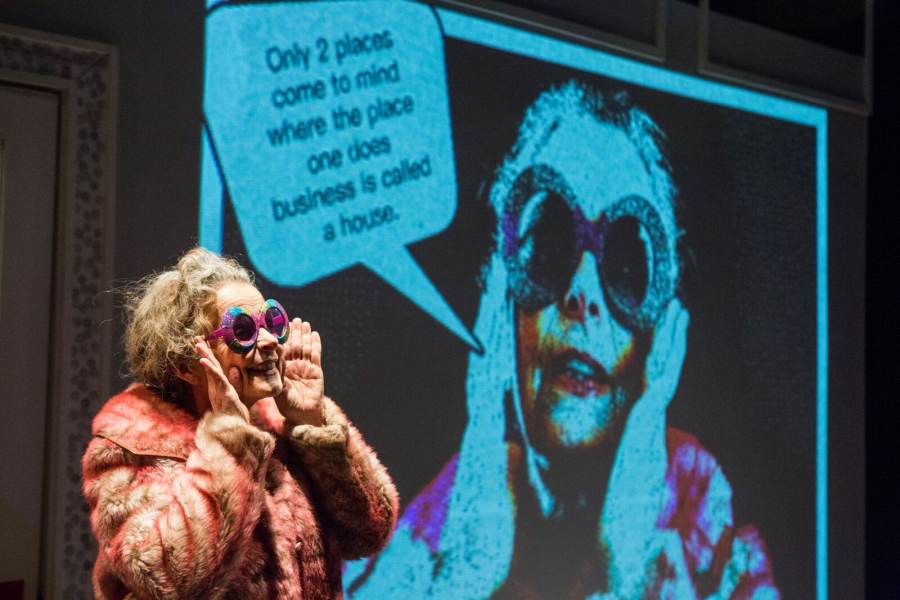

Mara Lieberman's new play Beneath the Gavel (from Bated Breath Theatre Company) is an immersive theater experience in which the audience members become bidders in an art auction. When theater-goers arrive, they receive fake cash, bid paddles, and crazy glasses to wear. 59E59 Theaters hosts the production - a perfect location, since the building used to be part of Christie's auction house. Both informative and entertaining, Beneath the Gavel mixes fluid storytelling and immersive theater to give viewers entry into the art world, pointing out the complications of a system in which art functions as commerce. Barbara Strongin, who has worked in art auctions at both Sotheby's and Christie's for 36 years, served as the play's consultant. We had the opportunity to ask Mara Lieberman - the play's writer and director - and Strongin a few questions about Beneath the Gavel, the world of art auctions, and the artistic process.
So first of all, I have to ask: why the glasses?
Mara Lieberman: Many people who come to Beneath the Gavel aren’t sure whether or not they are attending a real auction. The auction glasses mark that we are playing at something, that we are stepping into an imaginary world where Bated Breath bucks serve as currency that can win you real art. The audience steps into the role of a V.I.P. with millions to spend at an auction house like Christie’s or Sotheby’s and the glasses are so over-the-top that it pokes fun at the excess in that world. Wearing the glasses also gives the audience a feeling of being in costume or having a little anonymity, so that they can really play and transgress the social rules of everyday life. They can be outrageous if they want. It’s also a little nod to Sleep No More’s masks.
In your show, the fourth wall fluctuates quite a bit: sometimes it’s very strong, sometimes it’s practically non-existent. How do you balance that when you’re writing a script?
Mara Lieberman: The piece is an interdisciplinary performance, which intentionally veers from traditional dramatic structure. So, there’s fluidity in the audience’s relationship to the action. In terms of deciding how that experience is structured, the format of a scene has to serve the narrative. In just two hours, Beneath the Gavel explores the phenomenon that is the white-hot contemporary art market, follows a painting from creation to auction and immerses the audience into the world of a fine art auction house through immersive auction moments. Additionally, we’re balancing highly choreographed physical theatre with audience participation. The scene tells me as the writer the relationship we need to have with the fourth wall and the audience. There are moments when we open up the piece to improvisation and play and others where we need to drive the narrative and perform intricately constructed physical moments. In order to accomplish the story and theoretical underpinnings of the performance, it’s necessary to invoke and then disavow the fourth wall throughout the performance. It’s really a balancing act!

You’ve said you’re concerned about the declining audiences in museums and theaters, and that’s partly what inspired you to create pieces like Beneath the Gavel that mix theater and the art world. Do you have any thoughts on how we can increase attendance in these spaces?
Mara Lieberman: I think we need to question the assumptions we have about how audiences should interact with the material in both the theater and in the museum space. We are so wedded to traditional ways of behaving in these spaces but those covert and overt rules of engagement are not serving audiences. Audiences today don’t have a ton of time to spend. Many audiences don’t have the time or motivation to sit in a dark theater behind a hard fourth wall for hours.
Also, there’s a kind of isolation that happens when we are virtually connected all day long to other people on our phone screens. Our brains may be constantly stimulated, but I think people want to feel part of something bigger than our individual selves. Theater is the ultimate communal experience that happens because of presence in the body. It’s like everyone boards a bus together at the beginning of the show and the ride that happens on that bus is co-created by audience and actors. That creation is unique and unrepeatable and being physically present for that ride, having a visceral investment in that journey is part of what people want as an antidote to the isolation that happens behind the screens of our devices. We need to look at engaging people viscerally in the theatrical experience. And we need to question how you should behave and interact with art in theaters and museums if we want to nurture new audiences.
Beneath the Gavel is a combination of dialogue and semi-dance/choreographed movement. Why did you decide to play it that way?
Mara Lieberman: Bated Breath’s aesthetic uses physical theatre and visual metaphor to depart from everyday life and bring a visceral feeling of aliveness to performance. When I saw Theatre de Complicite in London in my 20’s, I had never seen physical theatre before and I was blown away. I knew I would spend the rest of my life exploring physical theater. Using the body to change space and time onstage, using expressive rather than naturalistic movement is not something we are as familiar with in the United States. The combination of choreography, music and other layered visual effects grabs an audience literally as it pries us from our everyday sense of temporal/spatial reality. Other moments are more intellectual or are about simple, meaningful connections between people, those moments beg for dialogue. But you’ll notice even those moments are not your traditional kitchen sink naturalistic interactions. We are always marking that this is play.
How do you think theater productions can involve the audience more, even if they’re not interactive or immersive productions?
Mara Lieberman: I think the agendas of the writer and director can impede audience connection to the material. Not everything has to be immersive or interactive. But, I think you do have to climb inside of the audience’s perspective and think about all that they are bombarded with each day: unending electronic stimuli, a perpetual stream of media options at their fingertips and most of all exhaustion by all their daily responsibilities and the impossible expectations we all live under. Why should they see your play? Why should they give their most precious commodity (their time) to your creation? How can you give them an unforgettable experience that energizes them? I think the answer lies in questioning our theatrical conventions and being generous with an audience in ways that may transcend those conventions. Theater needs to break expectations and depart from business as usual from the moment the audience buys a ticket.
Barbara, you’ve said that nothing surprises you any more in the auction world. Can you briefly tell us about the craziest thing you ever saw happen at an art auction?
Barbara Strongin: As you can imagine, I have many stories about things that have happened in the saleroom – both as an auctioneer, a phone bidder and a back-up auctioneer for the evening sales. Naturally, the stories about the secret signal bidders going horribly wrong were pretty crazy. Having their secret signals be obscured by overly large people sitting in front of them or realizing that “taking their glasses off” as a bidding signal was ill-conceived because the bidder then couldn’t tell if I had taken their bid or not were some of the highlights of craziness. Having a live bat fly into the saleroom during an auction was certainly a crazy experience as well. Thankfully, a bold client seated in the saleroom had the presence of mind to throw his coat over it when it swooped down and deposited it outside. I’ve even taken auctions where there were no bidders in the saleroom at all. Then there was a time when a crazy person walked into the saleroom, sat down and start bidding on every lot!
I’ve read that being an auctioneer at Christie’s requires a talent for acting and working the room. You even have a quasi-script in your auctioneer’s book. And I assume you do a lot of improv. As an auctioneer, did you enjoy that aspect of the job? Or did you dread it?
Barbara Strongin: Being an auctioneer requires many different skills. There are some math calculations required along with a bit of theatre. Your auctioneer’s book has the critical information you need to conduct an auction, but it is ultimately up to the skills of the auctioneer to react to what is happening in the room, on the phones and online, while making it fun and interesting for everyone. I enjoyed being the person responsible for enticing bidders to perhaps spend a bit more than they intended to, and you never really knew what was going to happen until it happens. I never dreaded taking the podium because I knew the rules of the “game” of auctioneering and thoroughly enjoyed the process - treating each lot like it was like a new day.
Are there any myths about the world of art auctions that you’d like to set the public straight about?
Barbara Strongin: Innocently scratching your nose does not buy the multi-million dollar picture. We can tell the difference between a real bid and an itchy nose….